


The TRACE images may be used without restrictions
in publications of any kind. We
appreciate an acknowledgement indicating that
the Transition Region and Coronal Explorer, TRACE,
is a mission of the Stanford-Lockheed Institute for Space
Research, and part of the NASA Small Explorer program. More information on
TRACE and other TRACE images can be found
here.

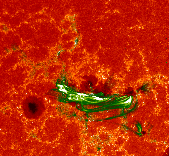 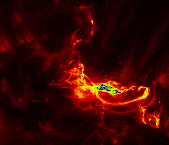  |
On 6 June 2000, TRACE observed two X-class flares (the largest, most
intense class of solar flares) in Active Region 1926. The image
on the top is a composite image
taken at 15:00UT showing a combination of the white-light, ultraviolet, and
extreme-ultraviolet images. In red, it shows the ultraviolet
continuum, which shows the small-scale
magnetic fields at the surface as yellow/orange
dots; a white-light image was blended in to show the location of the large,
dark sunspots. The green-white image is the 171Å image, showing the location
of the bright coronal loops. Note that the flare site runs over the middle
of the central spot complex (in which two polarities are joined in one
structure), and that they reach out toward the lower small spot as well
as to a ridge between the polarities running northward from the center. The central image is a 171Å EUV image taken at 15:10:15UT showing the very bright core (green and blue) of the flaring region, and some very bright loops around it. The structure running from the image center to the top is erupting, forming the start of a large coronal mass ejection. Notice the loop of magnetic field just to the left and below the center of the image; that loop and adjacent loops are uncoiling as they erupt. The lower image shows, for comparison, an image of the sunspot in AR 9026 at visible wavelengths taken between the X-class flares of 6 and 7 June, 2000. This was taken at the Swedish Vacuum Solar Telescope (SVST) at La Palma at 13:07 UT on 7 June, 2000. The full field of view is about 150 arcseconds. Note the fine double structure seen in the "light bridge" across the dark umbra that can be seen on this enlarged image. The image was taken with a G-band filter (4305A) and using the adaptive optics system ( http://www.astro.su.se/~rouppe/ao/ao.html ) at the SVST. It has not been processed or filtered, only rotated so that it has the same orientation as the TRACE images with north pointing upward. The observatory (http://www.astro.su.se/English/groups/solar/solar.html) is situated within the Spanish-International Observatory on the Roque de los Muchachos. There is much more information on this flare (including movies) on the SOHO pages.  |
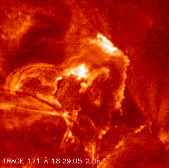 |
A solar flare observed at different
wavelengths: (left) the 171Å image shows plasma at about 1 million degrees;
(center) the 195Å image shows plasma at about 1.5 million degrees but also
shows very hot flare material through Fe XXIV lines; (right) the YOHKOH/SXT
image (with substantially poorer angular resolution) shows the hot
flare plasma with temperatures exceeding about 3 million degrees. This flare
was observed around 18:30UT on 27 June 1999. Courtesy: Kathy Reeves, SAO.
 |
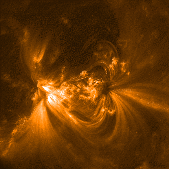 |
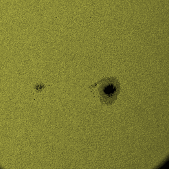
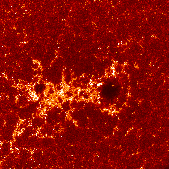 |
These three images of Active Region 9017
were taken at 14:01 UT on June 2, 2000. These images
show 3 different temperature regimes of the solar atmosphere. The
171Å image (gold) shows the million-degree corona. One can see various sets of
loops that connect the two sunspots which are visible in the white-light
image (yellow) as well as the 1600 image (red).
The white-light image (yellow) shows the solar surface
(the photosphere) and is at a temperature of about 6000 Kelvin. The sunspots
which are regions of the surface with large, concentrated magnetic fields,
have a temperature of about 4000 Kelvin. Courtesy: Dawn Myers.
 |
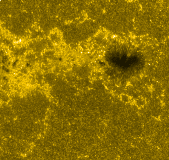 |
 |
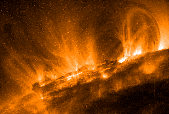 |
 |
 |
A combination of two images taken by
TRACE on 7 March 2000, around 00:25UT. The yellow image shows the
195Å passband, or plasma at approximately 1.5 million degrees. The
purplish image shows the brightest structures in the 1600Å passband,
which shows the location of magnetic field, with the exception of the
spots and small pores, which are dark at that wavelength. What makes
this image peculiar is the loop configuration in the red circle in the
full-sized image: coronal loops have their footpoints on a ridge running
right through the middle of a supergranular convection cell where there
is hardly any strong field either in bright faculae or in dark pores.
 |
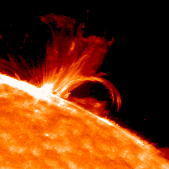 |
 |
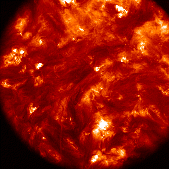 |
This 263-second exposure of the corona over the
quiet Sun shows the complexity of the corona. The image was taken in the
TRACE 171Å pass band, characteristic of plasma at 1 MK, near the center
of the solar disk, on June 10, 1998, at 20:40 UT.
The dark edges are caused by vignetting within the
telescope. The field of view is 1024x1024 pixels, of 375 km each.
 |
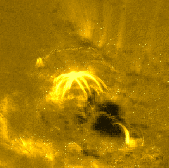 |
 |
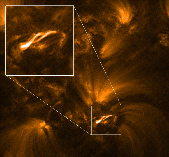 |
Sometimes TRACE observes coronal loops that
are wrapped around eachother (generally once, rarely more). This image,
taken on 4 April 2000, at 18:32UT (171Å; 1 million degrees)
shows an example of low-lying wrapped loops in AR8939. These loops form
part of a small filament complex, with hot loops lighting up briefly as
they evolve, wrapped around the generally much cooler loops of the
active-region filament. The field of view is 280,000 km to a side; the
zoomed-in field is a square with sides of 46,000 km.
 |
|
| Home | Mission | Instrument | Team | Operations | Results | Images | Movies | Education | Site Info. | |